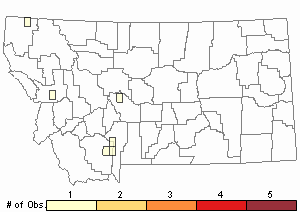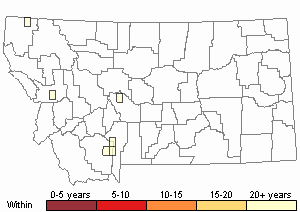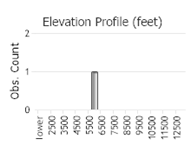View in other NatureServe Network Field Guides
NatureServe
Montana
Utah
Wyoming
Idaho
Wisconsin
British Columbia
South Carolina
Yukon
California
New York
A Dry Rock Moss - Grimmia ovalis
Other Names:
A Black Rock Moss
General Description
Plants: Acrocarpous. Growing in dense (Flowers 1973) to uncrowded clumps of erect shoots, deep green to black with brown tones (FNA 2007), brown below, the surface above somewhat silvery (Flowers 1973). Stems 1-3 cm long (FNA 2007), frequently branched (Lawton 1971); possessing a central strand (FNA 2007).
Leaves: Appressed and overlapping when dry, upright to spreading broadly when wet or the distal leaves spreading about 90 degrees from the stem (Lawton 1971), 1.7-4 mm in length, 0.4-0.8 mm in width, lance-shaped with ovate tendencies, cupped; margins flat, curved inward above (FNA 2007); base enveloping the stem slightly; apex piliferous, the hair-point finely toothed (Lawton 1971), usually with a slender attachment that is not decurrent along the margins (FNA 2007), but occasionally hair-point is stout and decurrent (Flowers 1973), 0.5-1 mm in length; costa slender at the base (FNA 2007), extending to the apex (Lawton 1971); leaves lower on stem becoming shorter and the lowest ones lacking a hair-point (Flowers 1973).
Leaf Cells: Lamina of 2 cell layers, or sometimes thicker in the distal region (Lawton 1971); upper laminal cells square with thick walls; middle laminal cells isodiametric with thick walls; basal laminal cells adjacent to the costa typically long (occasionally short and quadrangular) with walls wavy and thick; basal laminal cells near the margin green, usually transparent, square or elongate, straight, with thick crosswise walls (FNA 2007).
Diagnostic Characteristics
The similar G. longirostris has keeled leaves rather than concave, margins curved back and out rather than flat, and is autoicous rather than dioicous (FNA 2007).
Grimmia laevigata, which also resembles G. ovalis, has a costa that is very wide at the base (to 1/3 of the base width) rather than narrow (FNA 2007).
Range Comments
North American Range
YT, extending s from BC and AB to CA, AZ, NM, and TX, also MO, MN, ON, QC, NY, PA, and WV (FNA 2007). Known in MT from Carbon, Cascade, Flathead, Gallatin, Madison, Meagher, and Missoula Counties (Elliott 2016).
Observations in Montana Natural Heritage Program Database
Number of Observations: 6
(Click on the following maps and charts to see full sized version)
Map Help and Descriptions
Relative Density

Recency



 (Observations spanning multiple months or years are excluded from time charts)
(Observations spanning multiple months or years are excluded from time charts)
Habitat
Dry, partially exposed, noncalcareous rock, such as granite, sandstone, and basalt (FNA 2007, Elliott 2016). Elevation: Usually 3280-8200 feet (FNA 2007).
Reproductive Characteristics
Dioicous. Fruit produced somewhat infrequently. Perichaetial bracts larger than vegetative leaves. Seta 4-6 mm tall. Capsule carried beyond the perichaetial bracts, ochre; operculum long-beaked; calyptra hood-like (FNA 2007).
Stewardship Responsibility
References
- Literature Cited AboveLegend:
 View Online Publication
View Online Publication Elliott, J.C. and A.K. Pipp. 2018. A Checklist of Montana Mosses (1880-2018). Updated 3 January, 2020. Montana Natural Heritage Program, Helena, Montana. 73 pp.
Elliott, J.C. and A.K. Pipp. 2018. A Checklist of Montana Mosses (1880-2018). Updated 3 January, 2020. Montana Natural Heritage Program, Helena, Montana. 73 pp. Flora of North America Editorial Committee, eds. 2007. Flora of North America North of Mexico. Volume 27. Bryophytes: Mosses, Part 1. Oxford University Press, Inc., NY. xxi + 713 pp.
Flora of North America Editorial Committee, eds. 2007. Flora of North America North of Mexico. Volume 27. Bryophytes: Mosses, Part 1. Oxford University Press, Inc., NY. xxi + 713 pp. Flowers, S. 1973. Mosses: Utah and the West. Brigham Young University, Provo, Utah. 567 p.
Flowers, S. 1973. Mosses: Utah and the West. Brigham Young University, Provo, Utah. 567 p. Lawton, E. 1971. Moss Flora of the Pacific Northwest. Hattori Botanical Laboratory. Japan: Yamabuki-cho, Shinjuku-ku, Tokyo. 362 pages plus appendices.
Lawton, E. 1971. Moss Flora of the Pacific Northwest. Hattori Botanical Laboratory. Japan: Yamabuki-cho, Shinjuku-ku, Tokyo. 362 pages plus appendices.
- Additional ReferencesLegend:
 View Online Publication
View Online Publication
Do you know of a citation we're missing? Elliot, J. C. 1993. Second checklist of Montana mosses. Unpublished report. U.S. Forest Service, Region 1. Missoula, MT. 45 pp.
Elliot, J. C. 1993. Second checklist of Montana mosses. Unpublished report. U.S. Forest Service, Region 1. Missoula, MT. 45 pp. Lawton, E. 1971. Keys for the Identification of the Mosses on the Pacific Northwest. Reprinted from 'Moss Flora of the Pacific Northwest'. Published as Supplement No. 2 of the Journal of the Hattori Botanical Laboratory. Nichinan, Miyazaki, Japan. 66 pp.
Lawton, E. 1971. Keys for the Identification of the Mosses on the Pacific Northwest. Reprinted from 'Moss Flora of the Pacific Northwest'. Published as Supplement No. 2 of the Journal of the Hattori Botanical Laboratory. Nichinan, Miyazaki, Japan. 66 pp. Malcolm, B., N. Malcolm, J. Shevock, and D. Norris. 2009. California Mosses. Nelson, New Zealand: Micro-Optics Press. 430 pp.
Malcolm, B., N. Malcolm, J. Shevock, and D. Norris. 2009. California Mosses. Nelson, New Zealand: Micro-Optics Press. 430 pp. Smith, A.J.E. 1980. The Moss Flora of Britain and Ireland. Cambridge University Press, Cambridge. 705 pp.
Smith, A.J.E. 1980. The Moss Flora of Britain and Ireland. Cambridge University Press, Cambridge. 705 pp.
- Web Search Engines for Articles on "A Dry Rock Moss"





